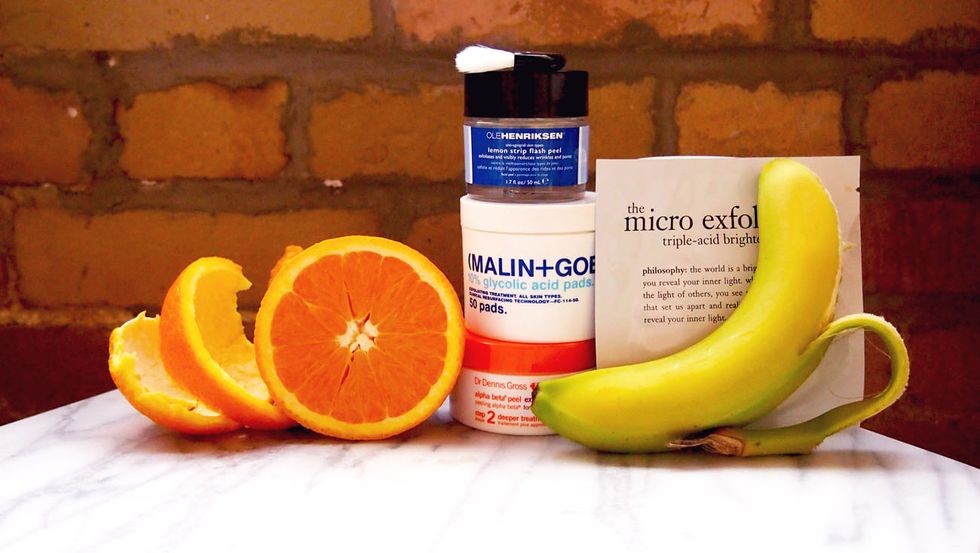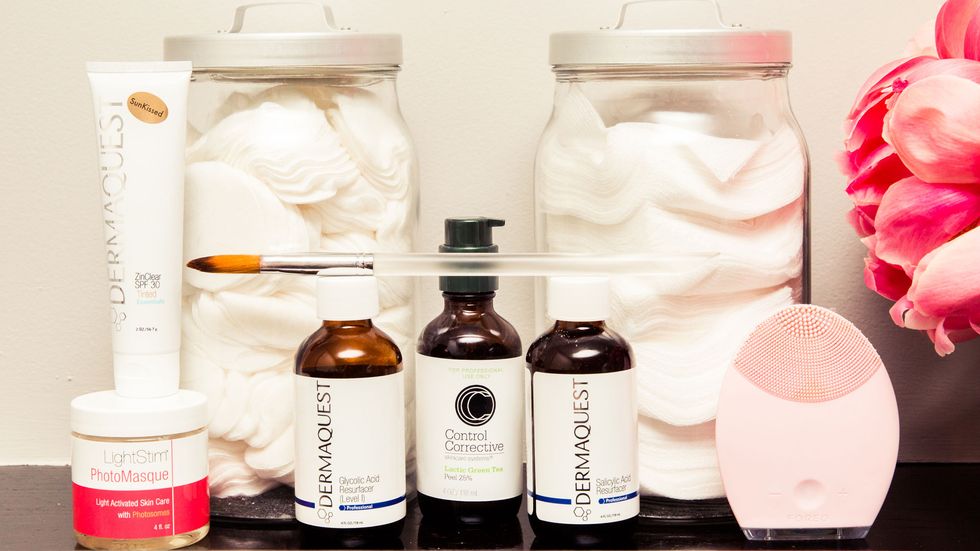A Comprehensive Guide to Skin-Care Acids
We consulted three skin specialists for their expert advice.
05 December, 2019
Skin
10 November, 2021
When you hear the term acid, where does your mind go? For some, your brain might conjure up images of bubbling vats of chemical compounds. For the beauty-obsessed, it’s a skin-care ingredient that shows up in everything from cult-favorite toners to nighttime anti-aging serums. But what do these different types of acids really do? And what is the best way to use them to get the results you want? What even *is* an acid, at its most basic level?
We decided to consult three specialists, plastic surgeon Dr. Melissa Doft and dermatologists Dr. Ellen Marmur and Dr. Doris Day, to learn about why this ingredient is so beneficial for your skin, what different types are out there, and why you should still approach acids with a healthy level of caution. Check out their answers below for a master class in skin-care acids.
We decided to consult three specialists, plastic surgeon Dr. Melissa Doft and dermatologists Dr. Ellen Marmur and Dr. Doris Day, to learn about why this ingredient is so beneficial for your skin, what different types are out there, and why you should still approach acids with a healthy level of caution. Check out their answers below for a master class in skin-care acids.

At its most basic level, what is an acid?
Dr. Marmur: “An acid is a molecule or ion capable of donating a hydrogen or capable of forming a covalent bond with an electron pair.”
Dr. Day: “For skin purposes, the most common acids are used as humectants (e.g., hyaluronic acid) and exfoliants (e.g., glycolic, salicylic, and trichloroacetic acid).”
What types of skin-care acids are there?
Dr. Marmur: “An example of a skin-care acid are AHAs, or alpha hydroxy acids, which work on the surface of the skin, gently dissolving the bonds between dead skin cells so that they can be easily removed. Another are BHAs, or beta hydroxy acids, which are also more commonly known as salicylic acid. This acid is oil-soluble, which can penetrate beneath the skin’s surface, cleaning out excess sebum from the pores and reducing oiliness.”
Dr. Doft: “Trichloroacetic acid is often used in chemical peels. Doctors will apply 20–35 percent or higher-strength peels to the face. After four to six days, the skin will peel, leaving younger, smoother skin beneath. Ascorbic acid, or vitamin C, is excellent for brightening the skin and stimulating collagen. Hyaluronic acid is best known for plumping (Juvaderm and Restylane) and hydrating. HA is able to absorb over 1,000 times its body weight in water, leading to fuller, more hydrated skin and thus decreasing fine lines. It’s found in the skin naturally but decreases with age.”
Dr. Day: “What separates one [acid] from another is the strength and level of skin penetration. Phytic and lactic acids are the most gentle; salicylic acid penetrates well into the pores and is self-neutralizing; glycolic acids can vary in strength and need to be neutralized to turn off their effect.”
What are the skin-care benefits of using acids?
Dr. Day: “Your dermatologist can evaluate your skin and determine if one of the [acids] is good for you to help with reversing sun damage, evening out skin tone, clearing acne, and more. Sometimes products are used as part of in-office peels, and often they are used in at-home skin-care regimens.”
How do you know if an acid is safe to use on your skin?
Dr. Marmur: “In order to know if an acid is safe for you, you first need to do a patch test. For this, you can put the acid on the back of your hand, and if, in 24 to 48 hours, there is no reaction, then you’re good to go!”
Dr. Doft: “Lactic acid is one of the mildest acids. It’s a great option for sensitive skin. You can also try an acid in a wash formula, which will limit the time that the acid is in contact with your skin.”
Dr. Marmur: “An acid is a molecule or ion capable of donating a hydrogen or capable of forming a covalent bond with an electron pair.”
Dr. Day: “For skin purposes, the most common acids are used as humectants (e.g., hyaluronic acid) and exfoliants (e.g., glycolic, salicylic, and trichloroacetic acid).”
What types of skin-care acids are there?
Dr. Marmur: “An example of a skin-care acid are AHAs, or alpha hydroxy acids, which work on the surface of the skin, gently dissolving the bonds between dead skin cells so that they can be easily removed. Another are BHAs, or beta hydroxy acids, which are also more commonly known as salicylic acid. This acid is oil-soluble, which can penetrate beneath the skin’s surface, cleaning out excess sebum from the pores and reducing oiliness.”
Dr. Doft: “Trichloroacetic acid is often used in chemical peels. Doctors will apply 20–35 percent or higher-strength peels to the face. After four to six days, the skin will peel, leaving younger, smoother skin beneath. Ascorbic acid, or vitamin C, is excellent for brightening the skin and stimulating collagen. Hyaluronic acid is best known for plumping (Juvaderm and Restylane) and hydrating. HA is able to absorb over 1,000 times its body weight in water, leading to fuller, more hydrated skin and thus decreasing fine lines. It’s found in the skin naturally but decreases with age.”
Dr. Day: “What separates one [acid] from another is the strength and level of skin penetration. Phytic and lactic acids are the most gentle; salicylic acid penetrates well into the pores and is self-neutralizing; glycolic acids can vary in strength and need to be neutralized to turn off their effect.”
What are the skin-care benefits of using acids?
Dr. Day: “Your dermatologist can evaluate your skin and determine if one of the [acids] is good for you to help with reversing sun damage, evening out skin tone, clearing acne, and more. Sometimes products are used as part of in-office peels, and often they are used in at-home skin-care regimens.”
How do you know if an acid is safe to use on your skin?
Dr. Marmur: “In order to know if an acid is safe for you, you first need to do a patch test. For this, you can put the acid on the back of your hand, and if, in 24 to 48 hours, there is no reaction, then you’re good to go!”
Dr. Doft: “Lactic acid is one of the mildest acids. It’s a great option for sensitive skin. You can also try an acid in a wash formula, which will limit the time that the acid is in contact with your skin.”

What is the best way to apply an acid to the skin?
Dr. Day: “Never start on the forehead. If any product drips, it will end up in your eyes. Some acids, like salicylic acid and trichloroacetic acid, become stronger if you layer them. Glycolic acid needs to be neutralized to turn off its effects. It’s very important to know end points of each product, i.e., how much frosting, redness, and burning sensation is normal, and for how long it should last, as well as what to use to help the skin heal and help you get the best results from the treatment.”
Can you layer acids?
Dr. Marmur: “You can layer acids as long as you know which ones to mix. You don’t want to use too many drying acids, as your face will become flaky and irritated. The safest bet is to just find the one acid that works for you, and stick with it. The more you layer, the more irritated and raw your skin will become.”
What is the biggest mistake you can make when using a skin-care acid?
Dr. Day: “Using [acids] on suntanned skin. Not properly neutralizing or removing it.”
Dr. Marmur: “The biggest mistake you can make is layering on too many acids at once. If you use too many exfoliating acids, your skin will become red and irritated. This will strip your skin of all of the good cells that help the new cells to grow. By over-complicating your routine, your skin will become more stressed.”
Are there any skin-care alternatives that can still provide the results of an acid?
Dr. Day: “Yes, there are excellent laser peels your dermatologist can do for you, like Clear and Brilliant or Fraxel Thulium laser treatments.”
Dr. Marmur: “One product that I recommend is the Marmur Metamorphosis Balance Serum. This serum targets those with acne, rosacea, redness, inflammation, and dryness, which are all things that these acids aim to avoid. Another product that I recommend is the SkinCeuticals C E Ferulic. This is a vitamin C serum which helps to reduce the appearance of fine lines and wrinkles, as well as reviving the skin’s complexion.”
Want more stories like this?
I Always Get Compliments on My Skin—These Are All the Products I Use
Why Cica Cream Is Our Latest K-Beauty Obsession
Expert Advice on How to Avoid Dry Skin
Dr. Day: “Never start on the forehead. If any product drips, it will end up in your eyes. Some acids, like salicylic acid and trichloroacetic acid, become stronger if you layer them. Glycolic acid needs to be neutralized to turn off its effects. It’s very important to know end points of each product, i.e., how much frosting, redness, and burning sensation is normal, and for how long it should last, as well as what to use to help the skin heal and help you get the best results from the treatment.”
Can you layer acids?
Dr. Marmur: “You can layer acids as long as you know which ones to mix. You don’t want to use too many drying acids, as your face will become flaky and irritated. The safest bet is to just find the one acid that works for you, and stick with it. The more you layer, the more irritated and raw your skin will become.”
What is the biggest mistake you can make when using a skin-care acid?
Dr. Day: “Using [acids] on suntanned skin. Not properly neutralizing or removing it.”
Dr. Marmur: “The biggest mistake you can make is layering on too many acids at once. If you use too many exfoliating acids, your skin will become red and irritated. This will strip your skin of all of the good cells that help the new cells to grow. By over-complicating your routine, your skin will become more stressed.”
Are there any skin-care alternatives that can still provide the results of an acid?
Dr. Day: “Yes, there are excellent laser peels your dermatologist can do for you, like Clear and Brilliant or Fraxel Thulium laser treatments.”
Dr. Marmur: “One product that I recommend is the Marmur Metamorphosis Balance Serum. This serum targets those with acne, rosacea, redness, inflammation, and dryness, which are all things that these acids aim to avoid. Another product that I recommend is the SkinCeuticals C E Ferulic. This is a vitamin C serum which helps to reduce the appearance of fine lines and wrinkles, as well as reviving the skin’s complexion.”
Want more stories like this?
I Always Get Compliments on My Skin—These Are All the Products I Use
Why Cica Cream Is Our Latest K-Beauty Obsession
Expert Advice on How to Avoid Dry Skin